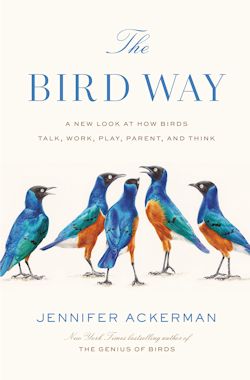SEJournal Online is the digital news magazine of the Society of Environmental Journalists. Learn more about SEJournal Online, including submission, subscription and advertising information.
BookShelf: “The Bird Way: A New Look at How Birds Talk, Work, Play, Parent, and Think”
By Jennifer Ackerman
Penguin Press, $28.00
Reviewed by Jennifer Weeks
It took me longer than I expected to read “The Bird Way,” not because it was boring (it’s not), but because I kept picking up my laptop to look for videos of the unique and often surprising bird behaviors that Jennifer Ackerman describes throughout the book.
 |
I also tested my family’s patience by constantly reading examples out loud to them (“Wait, you won’t believe this part ...”).
Ackerman is a science and nature writer who has authored eight books, including “The Genius of Birds.” In “The Bird Way,” she reports on findings from the past 20 years of bird research that have changed scientific thinking about how birds behave.
Some of these insights show that birds share behaviors with humans, including play, altruism and kidnapping.
“The Bird Way” surveys bird behaviors in five categories: talk, work, play, love and parent. In each area, studies are altering traditional views of how birds move through life.
Some of those insights suggest a new understanding of how birds’ brains work. A 2016 study showed that neurons in bird brains are smaller, more numerous and more densely packed than those in the brains of similarly sized mammals or primates.
“This tight arrangement of neurons makes for efficient high-speed sensory and nervous systems,” Ackerman writes. “Birds have shown us a different way to shape an intelligent brain.”
Other new findings reflect a more diverse set of scientists asking the questions.
For centuries, for instance, ornithologists thought that male songbirds sang to attract mates and compete with rivals, while females mainly listened and responded. But recent studies by women scientists show that in more than two-thirds of songbird species females sing too, for similar purposes.
Ravens playing catch, kea stealing hoses
Some of the best read-aloud examples are in the section on bird play.
Ravens, contrary to the gloomy reputation Edgar Allen Poe gave them, are among the most playful of all species. Their games include picking up twigs and flying with them, then drop-catching them in the air; hanging upside down by one foot while holding a toy or a piece of food, then switching the object from beak to foot and back again, time after time.
One captive raven was observed tossing
a ball in the air again and again and
catching it while lying on its back.
One captive raven was observed tossing a ball in the air again and again and catching it while lying on its back.
Kea – large green parrots native to mountainous zones of New Zealand – are just as playful … and also mischievous.
“At campgrounds in New Zealand’s Southern Alps, kea have been known to dive beneath parked vehicles and steal their engine hoses or to gnaw holes in the tops of camper vans,” Ackerman writes.
One scientist tells her that kea unscrewed the antenna from his rental car in three minutes.
The book isn’t just a collection of anecdotes. For each unusual behavior, Ackerman discusses what purpose it may serve.
For instance, play is an opportunity for birds to practice behaviors such as foraging and caching food. For kea, which flock in large groups without defined pecking orders, it’s also a way to welcome newcomers and integrate them into the gang.
Diversity, technology prompt breakthroughs
“The Bird Way” is also a great look at scientists in the field — puzzling over things they’ve observed, trying crazy field experiments, struggling through undergrowth, sometimes getting bitten by poisonous snakes.
As science becomes more diverse, Ackerman shows that research is improving. Bird scholars are paying more attention to tropical species that stay in one area year-round, instead of focusing on the migrants that are more prominent in North America and Europe.
New technologies, such as webcams, high-speed video and DNA analysis, are also changing the game.
“In one arena after another, birds are … showing us how consistently we have underestimated what’s going on in their minds,” Ackerman observes.
Only one warning: This book could turn you into a birder.
Jennifer Weeks is environment and energy editor at The Conversation U.S. She is based in Boston, is a former SEJ board member and is a regular contributor to SEJournal Online BookShelf.
* From the weekly news magazine SEJournal Online, Vol. 5, No. 33. Content from each new issue of SEJournal Online is available to the public via the SEJournal Online main page. Subscribe to the e-newsletter here. And see past issues of the SEJournal archived here.














 Advertisement
Advertisement 



